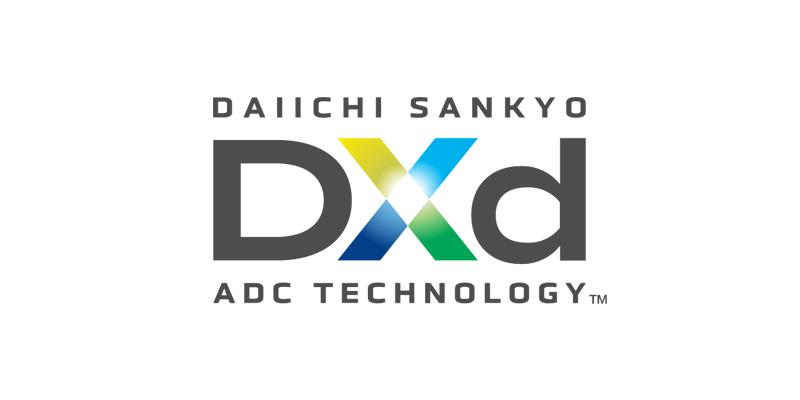Passion for Innovation.
Compassion for Patients.®
Creating New Standards of Care
We create essential medicine for longer, better lives.
Our Stories
The role of Medical Affairs is to bridge the gap between scientific research and real-world medical practice. After 17 years, I’ve seen firsthand ...
While our lungs support our very existence, we often don’t recognize that something isn’t quite right with our lung health. Get answers to questions about lung cancer and listen to empowered patients...

Transforming Science into Medicines
By uniting cutting-edge science and technology with a genuine interest in people, we develop high-quality, life-changing solutions for the patients of today and tomorrow with great care and unwavering dedication.
Striving to Create Optimized Antibody Drug Conjugate (ADC) Technology

DXd ADC Technology: Our innovations deliver on the benefits of ADC technology.
What's New
Dec 8, 2025
Daiichi Sankyo Showcases Strength of Industry-Leading ADC Portfolio with Latest Research Updates from Five Landmark Breast Cancer Trials at SABCSAdditional data from DESTINY-Breast11, DESTINY-Breast05, DESTINY-Breast09, DESTINY-Breast03 and TROPION-Breast02 reinforce practice-changing results of ENHERTU® and DATROWAY® across a broad spectrum of patients with breast cancer Trials-in-progress across breast cancer portfolio of Daiichi Sankyo demonstrate company’s commitment to creating new standards of care Science & Technology Day to be held following SABCS to discuss R&D and oncology business updates Tokyo and Basking Ridge, NJ – (December 8, 2025) – Daiichi Sankyo (TSE: 4568) will present new breast cancer clinical research across its DXd antibody drug conjugate (ADC) portfolio from more than 30 abstracts at the 2025 San Antonio Breast Cancer Symposium (#SABCS25), which include four rapid fire mini-oral sessions and other presentations from five landmark trials of ENHERTU® (trastuzumab deruxtecan) and DATROWAY® (datopotamab deruxtecan) across a broad spectrum of breast cancer. Four rapid fire mini-oral sessions will feature ENHERTU data in the curative-intent and metastatic settings of HER2 positive breast cancer, including two presentations from the DESTINY-Breast11 phase 3 trial highlighting patient reported outcomes (RF6-06) and further safety analyses (RF6-02) of ENHERTU followed by paclitaxel, trastuzumab and pertuzumab (THP) compared to dose-dense doxorubicin and cyclophosphamide followed by THP (ddAC-THP) in the neoadjuvant setting (before surgery) in patients with high-risk, locally advanced HER2 positive early-stage breast cancer. Additional efficacy and safety data (RF6-01) from the DESTINY-Breast05 phase 3 trial comparing ENHERTU to trastuzumab emtansine (T-DM1) as a post-neoadjuvant (after surgery) therapy in patients with high-risk HER2 positive early breast cancer with residual invasive disease in the breast and/or axillary lymph nodes also will be highlighted. The fourth rapid fire presentation will feature patient reported outcomes (RF6-07) from the ENHERTU plus pertuzumab arm of the DESTINY-Breast09 phase 3 trial as a first-line treatment of HER2 positive metastatic breast cancer. Interim results from DESTINY-Breast09 were recently published in The New England Journal of Medicine, marking the eighth pivotal trial of ENHERTU to be published in the prestigious journal. Additional updates from two other landmark breast cancer trials include poster presentations featuring the final analysis and five-year follow-up of efficacy and safety data (PS5-01-30) from the DESTINY-Breast03 phase 3 trial comparing ENHERTU versus T-DM1 as a second-line treatment of HER2 positive metastatic breast cancer, and further safety analysis (PS5-03-05) from the TROPION-Breast02 phase 3 trial of DATROWAY, the first trial ever to demonstrate a significant improvement in overall survival compared to chemotherapy as first-line treatment for patients with locally recurrent inoperable or metastatic triple negative breast cancer (TNBC) for whom immunotherapy is not an option. “Our latest research across these five landmark trials demonstrate how the DXd antibody drug conjugate portfolio of Daiichi Sankyo continues to potentially transform standards of care for patients with breast cancer,” said Ken Takeshita, MD, Global Head, R&D, Daiichi Sankyo. “We remain committed to following the science and collaborating with the breast cancer community to create innovative medicines that advance the treatment of breast cancer.” Additional data from the DESTINY clinical trial program to be highlighted in poster presentations at SABCS include an exploratory post-hoc subgroup analysis by hormone receptor status from the DESTINY-Breast12 phase 3b/4 trial (PS5-01-27) of ENHERTU in patients with HER2 positive metastatic breast cancer and brain metastases; the final results from the ENHERTU monotherapy and ENHERTU plus pertuzumab arms of the DESTINY-Breast07 phase 1b/2 trial (PS5-01-14) in patients with previously untreated HER2 positive metastatic breast cancer; and, initial characteristics of first enrolled patients from the DESTINY Breast Respond HER2 Low Europe non-interventional study (PS5-08-14) of ENHERTU in HER2 low metastatic breast cancer. Collaborations Supporting Innovation in Breast Cancer Research Additional data presented at SABCS include results from four externally sponsored trials across the DXd ADC pipeline of Daiichi Sankyo. Two spotlight poster presentations will report interim results from the HALLOW prospective observational trial (PD13-11) evaluating the efficacy and safety of ENHERTU in patients with HER2 low (IHC 1+ or 2+/ISH-) metastatic breast cancer with and without active brain metastases in Japan, and a post-hoc pooled efficacy analysis (PD13-10) from the TUXEDO-3 phase 2 trial of patritumab deruxtecan (HER3-DXd) in patients with HER2 positive metastatic breast cancer and active brain metastases or leptomeningeal disease previously treated with ENHERTU. Results from cohorts 1 and cohorts 2 of the TUXEDO-3 trial were recently published in The Lancet Oncology and results from cohort 3 were published in Nature Medicine. Two poster presentations will report on the intracranial and/or extracranial activity of ENHERTU and DATROWAY. A translational ctDNA analysis of intracranial and extracranial activity (PS2-08-20) of ENHERTU from the DEBBRAH phase 2 trial in patients with HER2 positive and HER2 low breast cancer with leptomeningeal disease will be highlighted, as well as results of intracranial activity (PS1-09-02) of DATROWAY from the DATO-BASE phase 2 trial in patients with HER2 negative breast cancer with leptomeningeal disease. Trials-in-Progress Across Breast Cancer Portfolio of Daiichi Sankyo Several trials-in-progress poster presentations at SABCS further highlight research underway to address a broad spectrum of unmet needs for patients with breast cancer. Additional externally sponsored trials for ENHERTU and DATROWAY include the PONTIAC phase 2 trial (PS5-07-15) evaluating ENHERTU versus CDK4/6 inhibitor-based endocrine therapy as a first-line treatment of non-luminal HR positive, HER2 low and HER2 ultralow advanced breast cancer; a phase 1b trial (PS5-09-22) evaluating ENHERTU in combination with valemetostat, an EZH1/2 inhibitor, in patients with HER2 low, HER2 ultralow and HER2 null metastatic breast cancer; and the TROPION-Breast06 phase 3b trial (PS5-07-21) of DATROWAY in patients with HR positive, HER2 IHC 0 inoperable or metastatic breast cancer refractory to endocrine therapy. Three additional trials-in-progress from the HERTHENA clinical development program of patritumab deruxtecan (HER3-DXd) also will be highlighted. These include the HERTHENA-Breast04 phase 3 trial (PS5-07-22) evaluating patritumab deruxtecan versus physician’s choice of treatment in patients with HR positive, HER2 negative unresectable locally advanced or metastatic breast cancer; the HERTHENA-Breast03 phase 2 trial (PS5-12-21) evaluating neoadjuvant patritumab deruxtecan plus pembrolizumab before or after pembrolizumab plus chemotherapy in patients with high-risk early-stage TNBC or HR low positive/HER2 negative breast cancer; and, the HERTHENA-Breast01 phase 1b/2 trial (PS5-12-23) evaluating patritumab deruxtecan in combination with HER2 targeted agents in patients with HER2 positive unresectable locally advanced or metastatic breast cancer. Science & Technology Day Daiichi Sankyo will hold its annual Science & Technology Day for investors on Monday, December 15, 2025, from 5:30 to 7:30 pm ET / Tuesday, December 16, 2025, from 7:30 – 9:30 am JST. Executives from Daiichi Sankyo will provide an update on R&D, business and manufacturing developments across the portfolio. Daiichi Sankyo Presentation Highlights at SABCS Presentation Title Author Abstract Presentation (CST) ENHERTU (trastuzumab deruxtecan; T-DXd) Patient-reported outcomes in DESTINY-Breast11: neoadjuvant treatment with trastuzumab deruxtecan (T-DXd) alone or followed by paclitaxel + trastuzumab + pertuzumab (THP) vs dose-dense doxorubicin + cyclophosphamide followed by THP (ddAC-THP) in high-risk, HER2+ early-stage breast cancer S. Modi RF6-06 Rapid Fire 6 Mini-Oral Session Wednesday, December 10 1:00 – 2:00 pm DESTINY-Breast11 safety: neoadjuvant trastuzumab deruxtecan (T-DXd) alone or followed by paclitaxel + trastuzumab + pertuzumab (THP) vs dose-dense doxorubicin + cyclophosphamide followed by THP (ddAC-THP) in high-risk, HER2+ early-stage breast cancer G. Curigliano RF6-02 Rapid Fire 6 Mini-Oral Session Wednesday, December 10 1:00 – 2:00 pm Additional efficacy and safety from the DESTINY-Breast05 study of trastuzumab deruxtecan (T-DXd) vs trastuzumab emtansine (T‑DM1) in patients with high-risk human epidermal growth factor receptor 2–positive (HER2+) primary early breast cancer with residual invasive disease after neoadjuvant therapy S. Loibl RF6-01 Rapid Fire 6 Mini-Oral Session Wednesday, December 10 1:00 – 2:00 pm Trastuzumab deruxtecan (T-DXd) + pertuzumab vs taxane + trastuzumab + pertuzumab (THP) for first-line treatment of patients with HER2 positive (HER2+) advanced/metastatic breast cancer: patient-reported outcomes from the DESTINY-Breast09 study M. Rimawi RF6-07 Rapid Fire 6 Mini-Oral Session Wednesday, December 10 1:00 – 2:00 pm Trastuzumab deruxtecan (T-DXd) versus trastuzumab emtansine (T-DM1) in patients with human epidermal growth factor receptor 2-positive (HER2+) metastatic breast cancer: final analysis from DESTINY-Breast03 S. Im PS5-01-30 Poster Session 5 Friday, December 12 12:30 – 2:00 pm Trastuzumab deruxtecan (T-DXd) monotherapy and T-DXd + pertuzumab in patients with previously untreated HER2+ unresectable/metastatic breast cancer: final results from DESTINY-Breast07 F. Andre PS5-01-14 Poster Session 5 Friday, December 12 12:30 – 2:00 pm Outcomes by hormone receptor status in patients with HER2+ advanced/metastatic breast cancer with brain metastases treated with trastuzumab deruxtecan (T-DXd): a post-hoc subgroup analysis of DESTINY-Breast12 H. Wildiers PS5-01-27 Poster Session 5 Friday, December 12 12:30 – 2:00 pm DESTINY-Breast Respond HER2 low Europe: description of first enrolled patients in the non-interventional study of T-DXd in HER2 low metastatic breast cancer V. Guarneri PS5-08-14 Poster Session 5 Friday, December 12 12:30 – 2:00 pm Interim analysis results for the effectiveness and safety of trastuzumab deruxtecan in patients with HER2 low breast cancer and brain metastases: the HALLOW study N. Niikura PD13-11 Poster Spotlight 13 Friday, December 12 7:00 – 8:30 am Translational analysis of cerebrospinal fluid and plasma circulating tumor DNA from breast cancer patients with leptomeningeal disease treated with trastuzumab deruxtecan (T-DXd) in the DEBBRAH trial A. Fitzpatrick PS2-08-20 Poster Session 2 Wednesday, December 10 5:00 – 6:30 pm Trials-in-Progress A randomized phase 2 study to evaluate the efficacy and safety of trastuzumab deruxtecan (T-DXd) versus CDK4/6 inhibitor-based endocrine therapy as first-line therapy of hormone receptor-positive and HER2 low/ultralow advanced breast cancer patients classified as non-luminal subtype according to gene expression profiling: the PONTIAC study J. Cortes PS5-07-15 Poster Session 5 Friday, December 12 12:30 – 2:00 pm Phase 1b study of EZH1/2 inhibitor valemetostat in combination with trastuzumab deruxtecan in subjects with HER2 low/ultralow/null metastatic breast cancer S. Damodaran PS5-09-22 Poster Session 5 Friday, December 12 12:30 – 2:00 pm DATROWAY (datopotamab deruxtecan; Dato-DXd) First-line datopotamab deruxtecan (Dato-DXd) vs chemotherapy in patients with locally recurrent inoperable or metastatic triple negative breast cancer (TNBC) for whom immunotherapy was not an option: additional safety analyses from the TROPION-Breast02 study T. Traina PS5-03-05 Poster Session 5 Friday, December 12 12:30 – 2:00 pm Intracranial activity of datopotamab deruxtecan (Dato-DXd) for patients with HER2 negative breast cancer and leptomeningeal disease: results from cohort C of the DATO-Base phase 2 trial P. Tarantino PS1-09-02 Poster Session 1 Wednesday, December 10 12:30 – 2:00 pm Trials-in-Progress TROPION-Breast06: multicenter, multinational, open-label, single-arm, phase 3b study of datopotamab deruxtecan (Dato-DXd) in patients with locally advanced inoperable or metastatic HR+/HER2 IHC 0 breast cancer refractory to endocrine therapy K. Jhaveri PS5-07-21 Poster Session 5 Friday, December 12 12:30 – 2:30 pm Patritumab Deruxtecan (HER3-DXd) Outcome of patritumab deruxtecan (HER3-DXd) in patients with HER2 positive metastatic breast cancer and CNS involvement previously treated with T-DXd: a subanalysis of TUXEDO-3 R. Bartsch PD13-10 Poster Spotlight 13 Friday, December 12 7:00 – 8:30 am Trials-in-Progress HERTHENA-Breast04: a phase 3, randomized, open-label study evaluating the efficacy and safety of patritumab deruxtecan (HER3-DXd) versus treatment of physician’s choice in hormone receptor positive (HR+)/human epidermal growth factor receptor 2 negative (HER2-) unresectable locally advanced or metastatic breast cancer B. Pistilli PS5-07-22 Poster Session 5 Friday, December 12 12:30 – 2:00 pm HERTHENA-Breast03: a phase 2, randomized, open-label study evaluating neoadjuvant patritumab deruxtecan (HER3-DXd) + pembrolizumab before or after pembrolizumab + chemotherapy for early-stage TNBC or HR-low+/HER2− breast cancer J. O’Shaughnessy PS5-12-21 Poster Session 5 Friday, December 12 12:30 – 2:00 pm HERTHENA-Breast01: a phase 1b/2, multicenter, open-label, dose-finding study to evaluate the safety and antitumor activity of patritumab deruxtecan (HER3-DXd) in HER2+ unresectable locally advanced or metastatic breast cancer S. Tolaney PS5-12-23 Poster Session 5 Friday, December 12 12:30 – 2:00 pm About the ADC Portfolio of Daiichi Sankyo The Daiichi Sankyo ADC portfolio consists of eight ADCs in clinical development crafted from ADC technology discovered in-house by Daiichi Sankyo. The DXd ADC Technology platform of Daiichi Sankyo consists of six ADCs in clinical development where each ADC is comprised of a monoclonal antibody attached to a number of topoisomerase I inhibitor payloads (an exatecan derivative, DXd) via tetrapeptide-based cleavable linkers. The DXd ADCs include ENHERTU® and DATROWAY®, which are being jointly developed and commercialized globally with AstraZeneca, and ifinatamab deruxtecan (I-DXd), raludotatug deruxtecan (R-DXd) and patritumab deruxtecan (HER3-DXd), which are being jointly developed and commercialized globally with Merck & Co., Inc, Rahway, NJ, USA. DS-3939 is being developed by Daiichi Sankyo. Additional ADCs being developed by Daiichi Sankyo include DS-9606, which consists of a monoclonal antibody attached to a modified pyrrolobenzodiazepine (PBD) payload and DS3610, which consists of an antibody attached to a novel immunomodulatory payload that acts as an agonist of STING. Ifinatamab deruxtecan, raludotatug deruxtecan, patritumab deruxtecan, DS-3939, DS-9606 and DS3610 are investigational medicines that have not been approved for any indication in any country. Safety and efficacy have not been established. About Daiichi Sankyo Daiichi Sankyo is an innovative global healthcare company contributing to the sustainable development of society that discovers, develops and delivers new standards of care to enrich the quality of life around the world. With more than 120 years of experience, Daiichi Sankyo leverages its world-class science and technology to create new modalities and innovative medicines for people with cancer, cardiovascular and other diseases with high unmet medical needs. For more information, please visit www.daiichisankyo.com. Media Contacts: Global/US Media: Jennifer Brennan Daiichi Sankyo jennifer.brennan@daiichisankyo.com + 1 908 900 3183 (mobile) Japan: Daiichi Sankyo Co., Ltd. DS-PR_jp@daiichisankyo.com Investor Relations Contact: DaiichiSankyoIR_jp@daiichisankyo.com
Dec 3, 2025
Federal Circuit Court of Appeals Vacates Infringement Judgment and Damages Award in Dispute between Daiichi Sankyo and SeagenTokyo and Basking Ridge, NJ – (December 3, 2025) – On December 2, the U.S. Court of Appeals for the Federal Circuit (the Federal Circuit) reversed a decision from the U.S. District Court for the Eastern District of Texas that found Seagen Inc’s U.S. Patent No. 10,808,039 (the ’039 patent) not invalid (the Texas decision). In view of the reversal, the Federal Circuit vacated the Texas court’s related infringement judgment and damages award against Daiichi Sankyo. In a separate decision, the Federal Circuit also dismissed as moot Seagen Inc’s appeal from the U.S. Patent and Trademark Office’s January 2024 Final Written Decision that invalidated all challenged claims of the ’039 patent, which Daiichi Sankyo had challenged in a post-grant review proceeding (PGR). This appeal was rendered moot by the Federal Circuit’s holding that the same claims were invalid in the appeal from the Texas decision. “We are pleased that the infringement judgment and damages award have been nullified.” said Naoto Tsukaguchi, Executive Officer and General Counsel, Daiichi Sankyo. About Daiichi Sankyo Daiichi Sankyo is an innovative global healthcare company contributing to the sustainable development of society that discovers, develops and delivers new standards of care to enrich the quality of life around the world. With more than 120 years of experience, Daiichi Sankyo leverages its world-class science and technology to create new modalities and innovative medicines for people with cancer, cardiovascular and other diseases with high unmet medical need. For more information, please visit www.daiichisankyo.com. Media Contacts: Global/US: Jennifer Brennan Daiichi Sankyo jennifer.brennan@daiichisankyo.com +1 908 900 3183 (mobile) Japan: Daiichi Sankyo Co., Ltd. DS-PR_jp@daiichisankyo.com Investor Relations Contact: DaiichiSankyoIR_jp@daiichisankyo.com
A Pipeline Pushing Us to Become a Global Leader in Oncology
Working with care and dedication, we’re developing new therapies that address the greatest needs in healthcare, making bold strides in cancer and other diseases.
Work with a Purpose
